
![]() 26 October 1962: The very last Boeing B-52 Stratofortress was delivered to the United States Air Force. B-52H-175-BW 61-0040, which was rolled out at Wichita, Kansas, 22 June 1962, was the 744th B-52 built by Boeing at its Seattle and Wichita plants.
26 October 1962: The very last Boeing B-52 Stratofortress was delivered to the United States Air Force. B-52H-175-BW 61-0040, which was rolled out at Wichita, Kansas, 22 June 1962, was the 744th B-52 built by Boeing at its Seattle and Wichita plants.
The B-52 Stratofortress is a long range strategic bomber powered by eight jet engines. The first flight took place 15 April 1952 at Boeing Field, Seattle, Washington, when test pilots Alvin M. (“Tex”) Johnston and Lieutenant Colonel Guy M. Townsend, U.S. Air Force, took off in the second prototype, the YB-52, serial number 49-231. The first production aircraft, B-52A-1-BO, 52-001, was rolled out at Boeing’s Plant 2 on 18 March 1954. The first operational Stratofortress, an RB-52B-15-BO, 52-8711, was delivered to the Strategic Air Command’s 93d Bombardment Wing (Heavy) at Castle Air Force Base, California, 29 June 1955. (52-8711 was retired 29 September 1965 and is on display at the Strategic Air and Space Museum, Offutt AFB, Nebraska.)
Boeing’s Seattle Plant 2 produced B-52 A, B, C model Stratofortresses, with D, E, and F versions built both there and at Wichita, Kansas. With the introduction of the B-52G, all bomber production was shifted to Wichita in 1957. The Wichita plant produced the B-52D through B-52H bombers from 1955 until production ended in 1962.
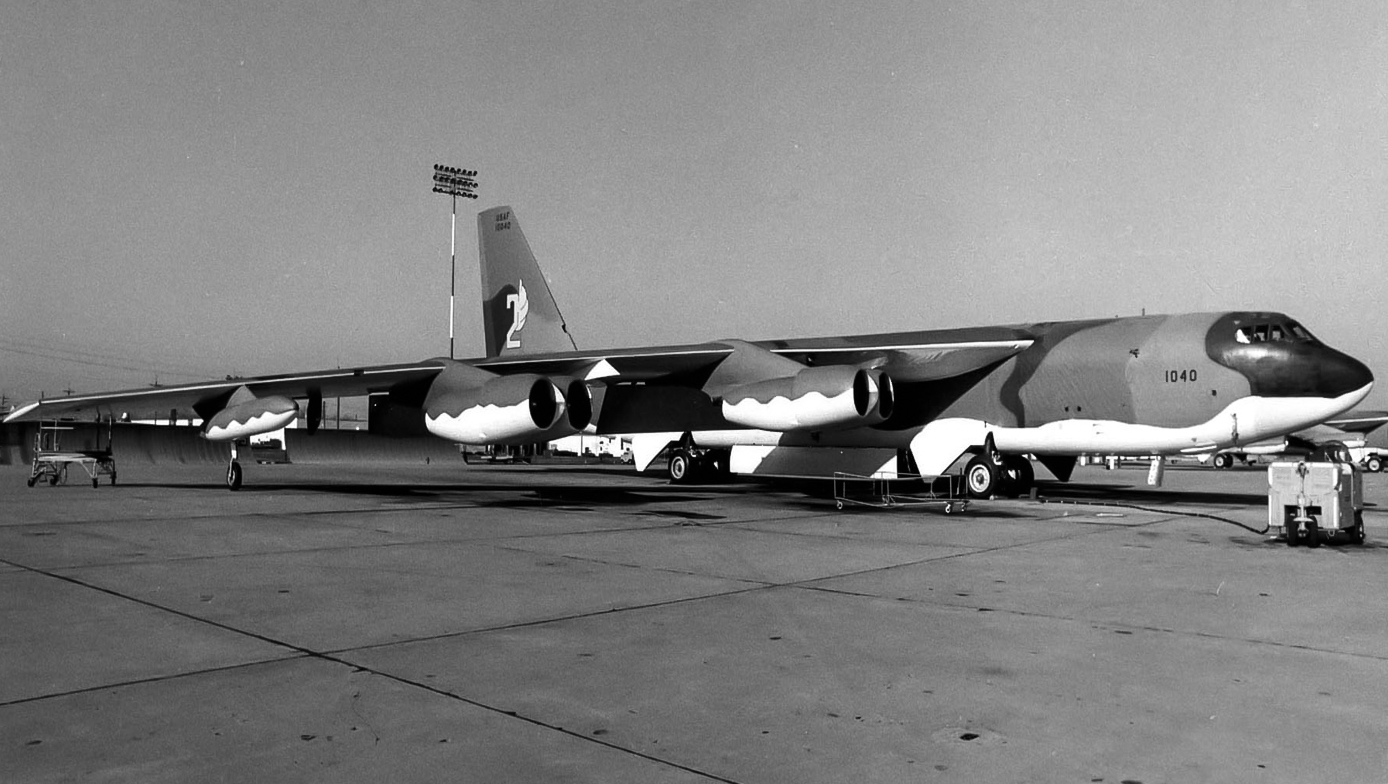
The Stratofortress was designed as a strategic bomber armed with nuclear bombs. It was originally powered by turbojet engines, but more powerful and efficient turbofan engines were introduced with the final version, the B-52H.
B-52D and B-52F Stratofortresses were first used in combat during the Vietnam War when they carried as many as 108 500-pound bombs to attack industrial targets in North Vietnam and enemy troop concentrations. Thirty B-52s were lost due to enemy action during the war. Most of these bombers were lost to radar-guided surface to air missiles. Three B-52D crews are credited with air-to-air victories, when they each shot down a Mikoyan-Gurevich MiG 21 interceptor with their four tail-mounted .50-caliber Browning machine guns. (The B-52H was equipped with a 20mm M61 Vulcan rotary cannon, though this has been removed.)
The Stratofortress was used during Operation Desert Storm in 1991, Operation Allied Force in 1999, and Operation Enduring Freedom from 2001 to the present.
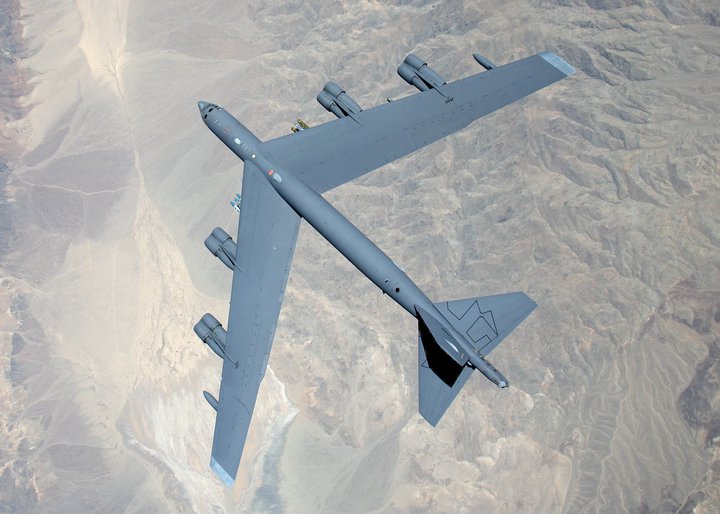
The B-52H is the only version still in service. The U.S. Air Force contracted 62 B-52H Stratofortresses, serial numbers 60-0001 through 60-0062, on 6 May 1960. A second group of 40, serials 61-0001 through 61-0040, were ordered later. All were built at the Boeing Wichita plant. As of 19 May 2016, 75 of the original 102 bombers, including 61-0040, are still in the U.S. Air Force inventory. Beginning in 2013, the Air Force began a fleet-wide technological upgrade for the B-52H, including a digital avionics and communications system, as well as an internal weapons bay upgrade.
The B-52H was developed to carry four Douglas GAM-87 Skybolt air-launched ballistic missiles on pylons mounted under the wings, inboard of the engines. The Skybolt was armed with a 1-megaton W-59 thermonuclear warhead. The program was cancelled, however, and the North American Aviation AGM-28 Hound Dog air-launched cruise missile was used instead. (Interestingly, the Hound Dog’s Pratt & Whitney J52-P-3 turbojet engine could be used to supplement the B-52’s takeoff thrust, and then refueled from the bomber’s tanks before being air-launched.)
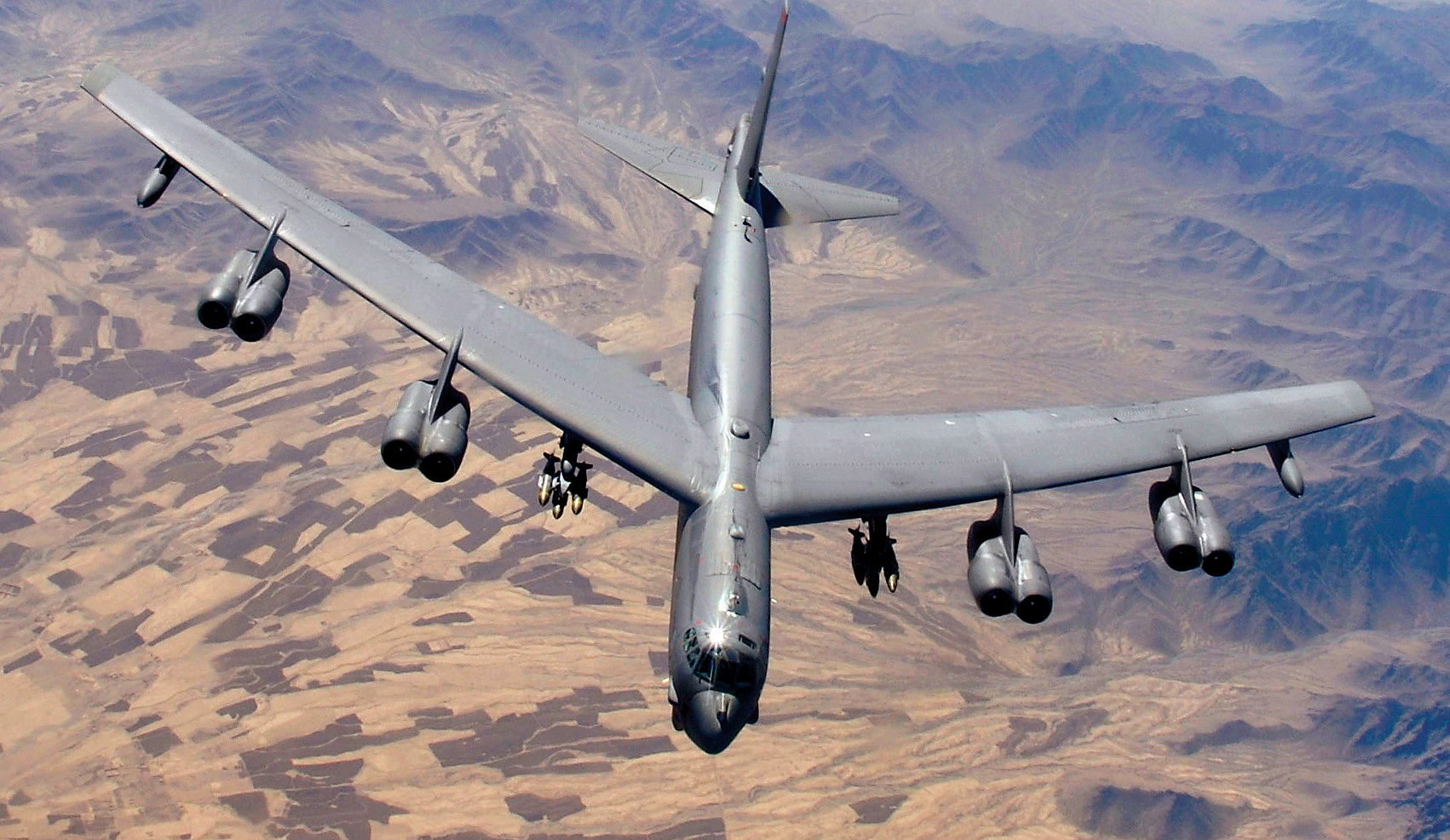
The B-52H is a sub-sonic, swept wing, long-range strategic bomber. It was originally operated by a crew of six: two pilots, a navigator and a radar navigator, an electronic warfare officer, and a gunner. (The gunner was eliminated after 1991). The airplane is 159 feet, 4 inches (48.565 meters) long, with a wing span of 185 feet (56.388 meters). It is 40 feet, 8 inches (12.395 meters) high to the top of the vertical fin. The B-52H uses the vertical fin developed for the B-52G, which is 22 feet, 11 inches (6.985 meters) tall. This is 7 feet, 8 inches (2.337 meters) shorter than the fin on the XB-52–B-52F aircraft, but the fin’s chord is longer.
The bomber has an empty weight of 172,740 pounds (78,354 kilograms) and its Maximum Takeoff Weight (MTOW) is 488,000 pounds (221,353 kilograms).
The wings of the B-52H have a total area of 4,000 square feet ( square meters). The leading edges are swept aft to 36° 58′. The angle of incidence is 6°, and there is 2° 30′ dihedral. (The wings are very flexible and exhibit pronounced anhedral when on the ground.) To limit twisting in flight, the B-52 has spoilers on top of the wings rather than ailerons at the trailing edges.
 The most significant difference between the B-52H and the earlier Stratofortresses is the replacement of the eight Pratt & Whitney J57-series turbojet engines with eight Pratt & Whitney Turbo Wasp JT3D-2 (TF33-P-3) turbofans, which are significantly more efficient. They are quieter and don’t emit the dark smoke trails of the turbojets. The TF-33 is a two-spool axial-flow turbofan engine with 2 fan stages, a 14-stage compressor section (7-stage intermediate pressure, 7-stage high-pressure) and and a 4-stage turbine (1-stage high-pressure, 3-stage low-pressure). The TF33-P-3 has a maximum continuous power rating of 14,500 pounds of thrust (64.499 kilonewtons) at 9,750 r.p.m., N1. Military Power, limited to 30 minutes, is 16,500 pounds (73.396 kilonewtons) at 10,000 r.p.m., N1. Each engine produces a maximum of 17,000 pounds of thrust (75.620 kilonewtons) at 10,050 r.p.m., N1, with a 5-minute limit. The TF33-P-3 is 11 feet, 4.32 inches (3.4625 meters) long, 4 feet, 4.93 inches (1.3442 meters) in diameter and weighs 3,900 pounds (1,769 kilograms).
The most significant difference between the B-52H and the earlier Stratofortresses is the replacement of the eight Pratt & Whitney J57-series turbojet engines with eight Pratt & Whitney Turbo Wasp JT3D-2 (TF33-P-3) turbofans, which are significantly more efficient. They are quieter and don’t emit the dark smoke trails of the turbojets. The TF-33 is a two-spool axial-flow turbofan engine with 2 fan stages, a 14-stage compressor section (7-stage intermediate pressure, 7-stage high-pressure) and and a 4-stage turbine (1-stage high-pressure, 3-stage low-pressure). The TF33-P-3 has a maximum continuous power rating of 14,500 pounds of thrust (64.499 kilonewtons) at 9,750 r.p.m., N1. Military Power, limited to 30 minutes, is 16,500 pounds (73.396 kilonewtons) at 10,000 r.p.m., N1. Each engine produces a maximum of 17,000 pounds of thrust (75.620 kilonewtons) at 10,050 r.p.m., N1, with a 5-minute limit. The TF33-P-3 is 11 feet, 4.32 inches (3.4625 meters) long, 4 feet, 4.93 inches (1.3442 meters) in diameter and weighs 3,900 pounds (1,769 kilograms).
The B-52H has a cruise speed of 456 knots (525 miles per hour/845 kilometers per hour). It has a maximum speed, with Military Power, of 555 knots (639 miles per hour/1,028 kilometers per hour) at 20,700 feet (6,309 meters)—0.906 Mach. The service ceiling is 46,900 feet (14,295 meters). The unrefueled range is 8,000 miles (12,875 kilometers). With inflight refueling, its range is limited only by the endurance of its crew.
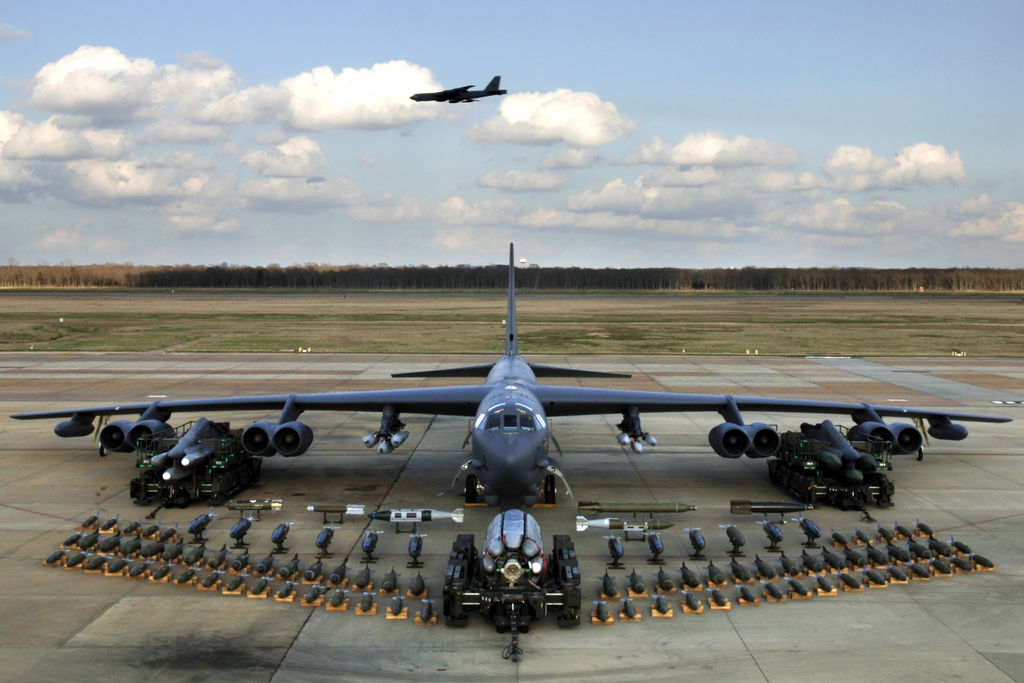
The B-52H can carry a wide variety of conventional free-fall or guided bombs, land-attack or anti-ship cruise missiles, and thermonuclear bombs or cruise missiles. These can be carried both in the internal bomb bay or on underwing pylons. The maximum bomb load is approximately 70,000 pounds (31,751 kilograms).
The B-52H was equipped with a General Electric M61 Vulcan 20 mm six-barreled rotary cannon (a “Gatling gun”) in a remotely-operated tail turret. The gun had a rate of fire of 4,000 rounds per minute, and had a magazine capacity of 1,242 rounds. After 1991, the gun and its radar system were removed from the bomber fleet. The flight crew was reduced to five.
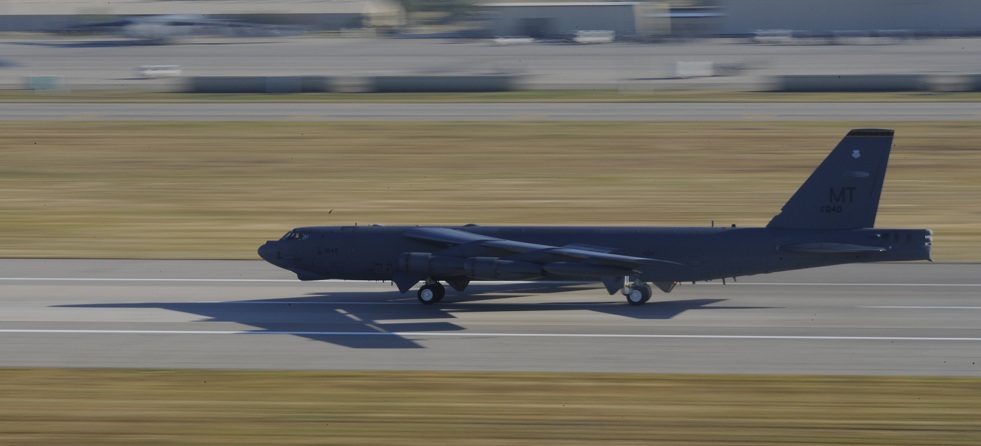
Beginning in 2009, eighteen B-52H bombers were placed in climate-controlled long term storage at Tinker Air Force Base, Oklahoma. In 2014, the entire fleet began a major avionics upgrade. As of December 2015, fifty-eight of the bombers remained in the active fleet of the United States Air Force and eighteen are assigned to the Air Force Reserve.
Recently, a B-52H-156-BW Stratofortress, 61-0007, Ghost Rider, was returned to operational status after eight years in storage at Davis-Monthan Air Force Base, Tucson, Arizona. 45,000 man-hours were required to restore the bomber.
The B-52H is expected to remain in service until 2040.
61 years after roll-out, 61-0040 is still in service with the United States Air Force, assigned to the 23rd Bomb Squadron, 5th Bomb Wing at Minot Air Force Base, North Dakota.
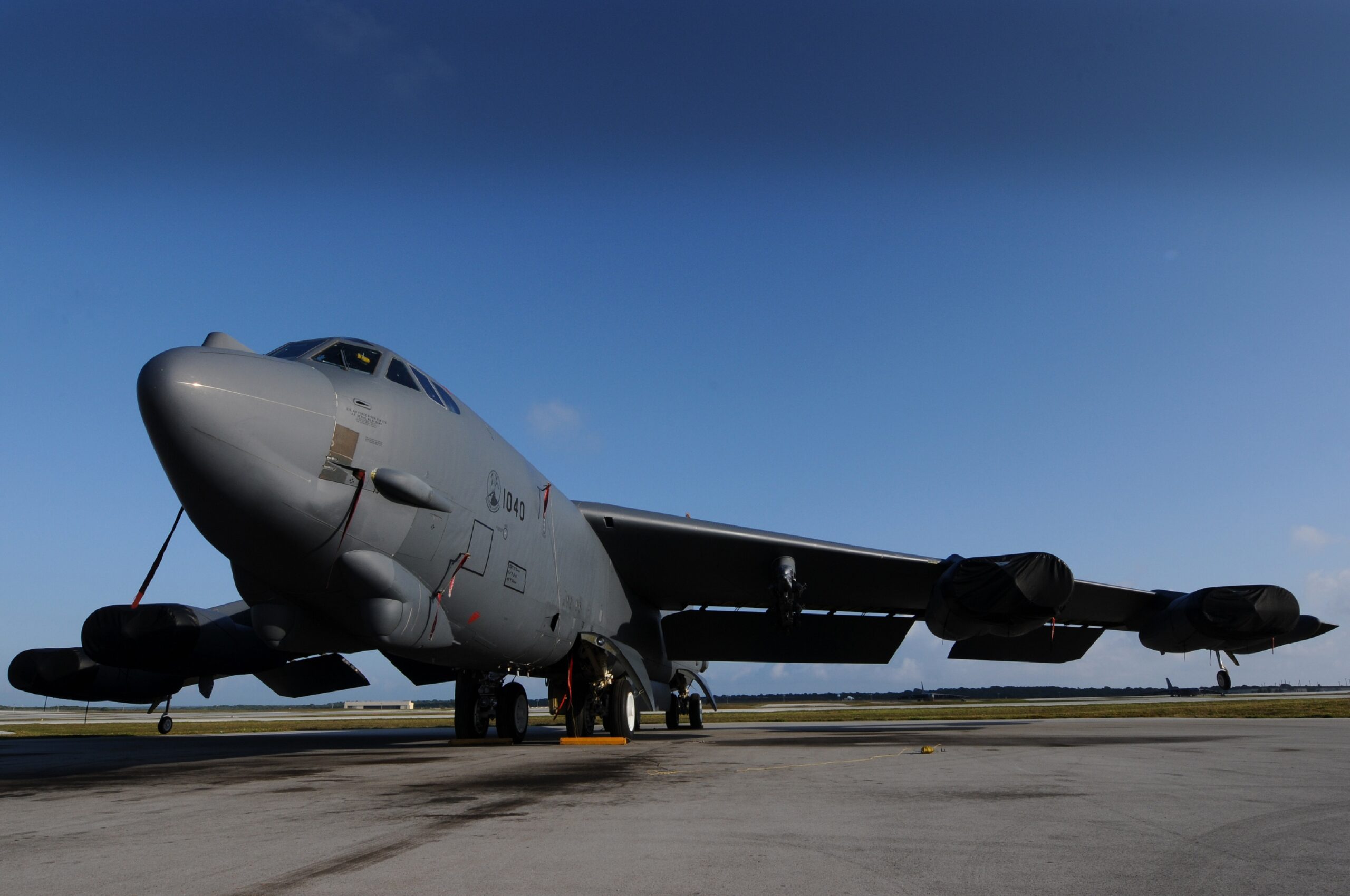
© 2019, Bryan R. Swopes
I’m sure I won’t be the first (or last) to point out that Carswell AFB is in Texas, not California. Good piece on the B-52, regardless. Keep it up.
Thank you, Byron. This is what happens when you write something at 2:00 a.m.
Was this Oct 26 or 20? It says 26 in headline but 20 in the article
Ooops. Typo. The 26th.
October 20, 1962 was the day North Korea captured the Pueblo.
The day my oldest daughter was born and the old nurse told my very young wife “your husband is going to WAR! Just what a new mother wants to hear ☹️????❤️❤️
USS Pueblo was captured 23 January 1968.
Was the B-52 actually delivered to the USAF from Seattle or Wichita or were they flown to an USAF base and accepted there? I remember talking to officials at Grant County International Airport in Moses Lake Washington which used to be Larson Air Force Base. They claimed that all B-52’s were flown there to that base and were accepted into the USAF before being transferred to various bases.
Good question, Isaac. I don’t know, but will try to find out.
Sure enough, Carswell AFB is in Texas, but Castle AFB is in California.
October 1962 . . . Sounds like the Cuban Missile Crisis
Bryan, excellent article. Loads of good information. Is there a source of a printed “slick copy”? I would like to add this to my collection of articles and info on the B-52’s.
I am also curious what the air-frame hours are now on that 61-040 aircraft. It’s pure trivia but we had that aircraft at Homestead when I was there 1963-66. Being the last B-52H built we were flying it very frequently…called “Lead the fleet” program. Who would have guessed it would still be in service almost sixty years later. 61-040 had 4,000 hours on it back in 1966. Seems like it was double the similar tail numbers. This longevity is a tribute to the manufacturer, all of the systems used, the flight crews and of course the maintenance crews over this lifetime.
Yeah I was stationed at Carswell from 1985-1991. Was a part of putting the first B-52H on alert that was ALCM loaded (on the wings). Not sure the year probably 1987. I have the certificate….somewhere. Believe the aircraft was either 60-0018, or 61-0018. It was something eighteen. Then I was associated with the first successful test and placing on alert a CSRL loaded Buff. (61-038) I know this for sure because it was my plane. (1990) I have the certificate and patch.
I recall that the final Buff was delivered to the 5th BMW which was then stationed at Travis AFB, Ca.
The B52’s flew out of Seymour Johnson AFB Goldsboro, N.C. . What an amazing aircraft. I was stationed at SJAFB twice in the 70. Saw many launches of the alert Buff’s.
I know some B-52’s were first flown to Boeing’s Flight Test Center at Larson AFB. I was stationed there and my brother-in-law was a test pilot for Boeing. From there they were delivered to Air Force Bases. When production moved to Wichita that probably ended. I was in Alaska by then. I was at Larson from 1956 to 1961.
When I left Minot in 2000 1040 had a little over 18,000 hours on it. It was the highest time airframe on the base. Most ranged between 12,000 and 15,000 hours.
Where at Tinker are they keeping B-52s in climate controlled storage? I know about 13 H models were sent to the boneyard at DM around 2009, 2 of which have been pulled back out and put back into service. But I don’t think there are any being stored at Tinker.
I was a B-52H crew chief in 1964 at Homestead AFB and 61-040 was there and the lead the fleet aircraft. I crewed 60-043.
Ron, did you ever work with Richard “Pup” Schick while you was stationed at Homestead ?
Damning indictment for the UK that we can’t even keep one of our 1960 Nuclear Deterrent bombers flying for exhibition and US still use them in front line service
Ron I was stationed at Edwards AFB in Cal from 1971 to 1981 I was with NASA for 3 years worked
on B52 Tail # 008 Jet Engine Technical
If you’re in southern California and want to see a B-52, go to the Joe Davies Heritage Airpark in Palmdale. I’m retired from Tinker AFB, OK and worked on the project when we moved a B-52 across town to the Fairgrounds. (No small feat.) Later, when the Fairgrounds was remodeled, the plane made its way to California. A few years ago we visited it there and showed the museum folks the photos of the move. It’s a 57 model, Tail #0038
I was a dependent living at Eglin AFB in the early 60s. At that time they had a SAC wing of B 52s and on occasion I was passing the end of the runway on my motor scooter when they scrambled the Buffs. They say watching the space shuttle was an awesome sound and sight to behold. I am here to tell you having bomber after bomber pass overhead under full throttle was also awesome. The interval between the bombers was around 30 or 40 seconds if I remember correctly, but that was a minute ago.
Outstanding pictures, the BAFB Eaker needs to have an B52 for our future Nation Cold War Museum , speak for us tell everyone about it, This Old base is set to give each Branch, Army, Navy, Marines, Coast Guard, Missile, and Airforce an building to display the Cold War affected Making it National Cold War please pass this to all veterans come and visit